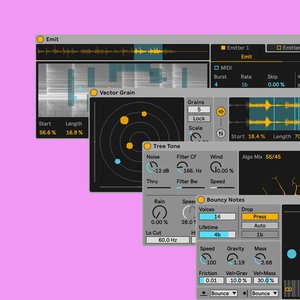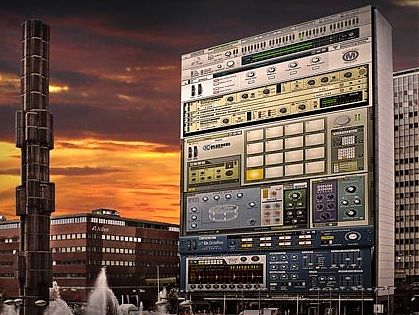Using a separate Max for Live installation. Live Versions: All Operating System: All Max for Live is ready to use once Live is installed. If needed, you can use a different version of Max instead of the one that comes bundled in Live. Included in Live 11 Suite. Probability Pack is a set of five creative sequencers that allow you to add controlled randomization to your composition and performance process. Each sequencer has a unique way of adding subtle or extreme randomization to patterns for unpredictable outcomes. Use these sequencers to generate new ideas, create. Midi2themax has introduced MXL PACK, a collection of 40+ MIDI Max For Live devices for Ableton Live 10 and 11. Features: quantize melodies and chords to 400 scales – change the scale dynamically by sending notes from Live clips/tracks; chromatic, diatonic and rotating harmonizers, with different velocity, delay and target track for each.
If you are an Ableton Live Suite owner, you’ll definitely want to take advantage of the many unique music production and sound design tools Max for Live has to offer! Max, originally developed by Cycling’74 in the late 90’s has since been renowned as one of the world’s leading tools for sound designers, interactive composers and music technologists. Max for Live is a special version of Max that operates within Ableton Live 9 Suite. What makes it so awesome is it’s ability to offer custom tools and macros for building a wide variety of devices to manipulate incoming MIDI signals and digital audio.
Recently, Ableton and Cycling’74 announced some great Max for Live devices you should know about; AND some of these devices aren’t just useful for producers. They are also for live performers and those integrating computers and electronic elements into bands.
First, meet BeatSeeker by developer Andrew Robertson. This device has some really cool tempo-syncing features you can use when performing live. The device works by “detecting the BPM of any incoming, rhythmic audio signal and matching Live to its tempo”. All you need to do is set up a microphone with a rhythmic audio signal going into Live, have Max for Live opened and BeatSeeker enabled on the track. From there, Live’s master tempo will adjust in real time to the changing tempo of the incoming audio.
While we haven’t extensively tested it with a variety of audio sources just yet, it seems like a great addition to the ever-expanding tools Live offers for improvisation and experimentation for “live” electronic music. You can purchase this device for $29 right from Ableton’s online store.
In addition to the release of BeatSeeker, Cycling’74 also recently announced the release of Max version 7. This update brings some new features and to highlight some of them, Ableton and Cycling’74 are offering 18 unique devices that 100% free to download. These devices categories include sample playback, pitch shifting, pitch analysis, vocoding, retuning and MIDI sidechaining. All of the devices in this free pack highlight some of Max 7’s new and unique algorithms for real-time intonation, pitch and time correction.
Last, we want to take a moment to tell you about another great download from the innovative Max for Cats developer called OSCiLLOT. This collection of modules allows you to create a virtual modular dream synth right inside your DAW. While the full version of OSCiLLOT costs $99, there is a free download version called OSCiLLOT Lite which includes 26 cool modules so you can get started patching and building yojur own instruments right away. If you’ve ever used Native Instruments Reaktor to build your own instruments, OSCiLLOT has somewhat of a similar workflow. It’s also a great tool for picking up some sound design and signal flow techniques along the way.
These devices allow you to connect, control and monitor Live with a range of innovative technologies and communication protocols. Use LEGO® MINDSTORMS® EV3, Arduino, or littleBits™ to connect up sensors, lights or motors, open your sound world up to the web through JSON-based APIs, or convert OSC data to MIDI data. The list of input and output possibilities for music & sound creation with Live is almost endless.
The Pack consists of 11 Max for Live devices: a toolkit for exploration, or to open up in Max and adapt to your own needs (Max programming knowledge is required for this!). Some devices demonstrate how you can use each protocol to capture different types of data.
You can get the pack using the download button to the right or by forking our repository on GitHub.

Here’s more on how you can use each device.
Hardware
LEGO® MINDSTORMS® EV3 – Connect an EV3 Programmable Brick to Live and get access to its sensors and motors.

Arduino - Connects switches, potentiometers and other sensors to control Live parameters, or use Live to control LEDs or Servos connected to an Arduino Uno.

littleBits™ - use the littleBits Arduino with other input/sensor Bits to control Live. It also enables events in Live to control your other littleBits modules. Find out more about littleBits at littleBits.cc
Camera – fetches webcam data in order to control mappable parameters.
OSC devices

Ableton Live Max Tracks
OSC Send – converts any mappable Live parameter to OSC data for sending out of Live.
OSC TouchOSC – allows you to map any controller from any available TouchOSC layout to live elements.
OSC Monitor – a simple but useful OSC data monitor.

OSC Leap Motion – uses Leap Motion to generate midi notes with the help of the ManosOsc application.
OSC MIDI Send – sends MIDI note and velocity data as OSC messages to a Processing sketch.
JSON devices
JSON Weather – one of two examples on how to fetch JSON data from the internet, parse it through dictionaries and query specific data content from it.
This example device is powered by the Dark Sky API
Ableton 9 Full Max For Live Packs
JSON Video – the second example device on how to fetch web data in JSON format: uses #ableton tagged looped videos from the online video sharing service “Vine”.